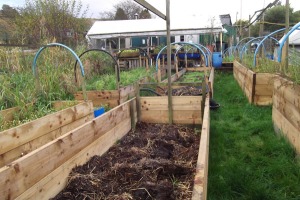Many people in Britain are growing their own vegetables for the first time. In a country which currently only produces 60% of its food supplies, that’s always a good move. It’s taken the uncertainties of Brexit to bring this home.
Emergency planning is the same motive that inspired me to create the Resilience Garden over a decade ago. I feel for those people out there at the beginning of their journey; the frustrations they will face and the triumphs they’ll enjoy!
There’s a lot to learn about resilience gardening. so much that I had to write another book about it. Here’s a selection of top tips from ‘Recipes for Resilience‘ :-
- It’s all about soil. Look after it, feed it, don’t tread on it. Use raised beds, keep to paths.
- A planting chart on your wall saves having to leaf through books or websites with muddy hands.
- If you don’t have an outside tap, fill a bucket with clean water ready to rinse your hands. You’ll need them clean and dry to handle seeds.
- Look after your tools; give them a wipe and put them away at the end of each session.
- If you’re using stakes, cover the ends with padding so they don’t poke you in the eye. It’s hard to see them from above!
- Collect old buckets and basins. Placed strategically around the garden, they will harvest rainwater for you, saving a trip from the tap. Make sure wildlife can escape from the water, and watch out for slugs moving in underneath.
- You have to squish slugs and snails. Sorry. Once hedgehogs and thrushes would have done the job for you, and if you poison your pesky molluscs this day will be so much further away.
- You also have to thin out vegetables like carrots. Steel yourself to compost those little baby plants! Avoid this trauma by becoming an expert at sowing thinly.
- Cultivating vegetables is a compromise between what you like to eat and what the garden wants to grow. Allowing the garden to win gives you much less work. Leeks are just as useful as onions.
Do not dig up your potatoes to see if they are growing!
Happy gardening!
‘Recipes for Resilience‘ covers the whole growing year, with gardening tips, seasonal recipes and historical background. I’m excited to announce that the book is now available through Amazon and other regular outlets!
Meanwhile, I’m having to change publisher for the Resilience Handbook as well – if you want one of the limited first edition copies, order now!





